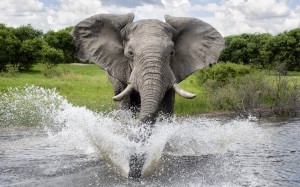Falling Down the Thames Blog 35, 12th November 2014
Falling Down the Thames in the Classroom
When I was a primary school student, almost fifty years ago, an adventurer came to my school. Everyone was herded into the auditorium to hear the gentleman speak. After about twenty minutes of gabbing, he showed the start of a black-and-white film about his recent trip to Africa. Just as the film reached the point at which the adventurer was about to be killed by an elephant, the film stopped. We were told that if we wanted to see the rest of the film, we would have to return to the school that evening, and pay ten cents each. The remainder of the film was rather good, as I recall, and well worth my allowance for the week. The elephant changed its mind about charging at the last moment.
Films about adventures of this sort, in school, cinemas or on television, were the hottest thing in entertainment in the middle and late 1960s. Sixty minute television specials by Jacques Cousteau and Jane Goodall were anticipated for months. Now that I am one of those adventurers, I take every opportunity to speak to school students about the wonders of the natural world. I like to think that my visits to primary schools in Calgary to show off an assortment of snakes and turtles were eagerly anticipated.
As part of our Falling Down the Thames paddling adventure, Krista and I will be speaking to students at five schools next year. One is in Canada, and the others are in England, along our paddling route. The schools are:
William G. Miller Elementary in Toronto; about 520 students. On Thursday 16 April, Krista and I will make our first presentation about Falling Down the Thames at the school where I was a student between 1963 and 1967, and where I saw the film about the African trip. The following day we will fly to England to begin our adventure.
Kemble Primary School in Kemble; approximately 100 students. This school is the closest one to the head of the River Thames. This presentation will be on Monday 20 April, the day before Krista and I start paddling.
Battle Primary Academy in Reading; about 450 students. Reading is the largest city on the Thames outside of greater London. We will visit with these students on Friday 24 April, having completed about 145 kilometres of paddling.
Green Dragon Primary in London; more than 400 students. We will be more than half-way through our adventure when we speak with students in the London suburb of Brentford the north shore of the River Thames on Wednesday 29 April.
Reculver C of E Primary in Herne Bay; about 475 students. Wednesday 6 May will be our second last day of paddling when we will stop to speak to students at Herne Bay. This community is on the north shore of Kent.
Of these five presentations, the last might be the one closest to my heart. Reculver C of E Primary was the school of my mum and my uncles Desmond and Gerald. Krista and I will be making our presentation seventy-five years after they attended school in Herne Bay.
- Glen
Photo credits: charging African elephant – Ben Cranke, www.telegraph.co.uk; Green Dragon – www.greendragonprimary.co.uk; Reculver C of E Primary School banner – www.reculver.kent.sch.uk



